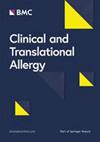Childhood asthma is a heterogeneous disease that exhibits different characteristics and varying severity; however, the metabolite alterations underlying the difference in asthma severity, especially in severe asthma, are not well understood. The aim of this study was to identify the plasma metabolic profile of children with different asthma severity and explore the potential intervention targets in severe asthma and glucocorticoid resistance.
Untargeted liquid chromatography mass spectrometry was utilized to analyze plasma metabolites in 54 children with mild-to-moderate asthma, 50 children with severe asthma and 39 healthy controls. Multivariate statistical analyses were used to explore plasma metabolic alterations that were strongly associated with asthma severity. Meanwhile, the severe allergic airway inflammation mice with glucocorticoid resistance were constructed to validate the potential therapeutic capacity of metabolites.
The plasma metabolic profiles of children with mild to moderate asthma and severe asthma exhibited significant alterations. The distinct plasma metabolite shifts were accompanied by functional alterations in lipid metabolism, particularly choline metabolism, glycerophospholipids and sphingolipid metabolism. 11-cis-retinol, LysoPC (20:4 [8Z,11Z,14Z,17Z]), and glycerophosphatidylcholine were associated with exacerbated airway inflammation and lung function. Furthermore, 2-Hydroxyestradiol, LysoPC (18:3 [6Z,9Z,12Z]), zeaxanthin, and betaine were shifted exclusively in the severe asthma group and may serve as potential biomarkers. Subsequent in vivo studies demonstrated that betaine supplementation partially improved glucocorticoid resistance.
Overall, children with different asthma severity displayed distinct plasma metabolic patterns. These may contribute to the difference in response to glucocorticoids in childhood asthma and could be potential targets and interventions.



